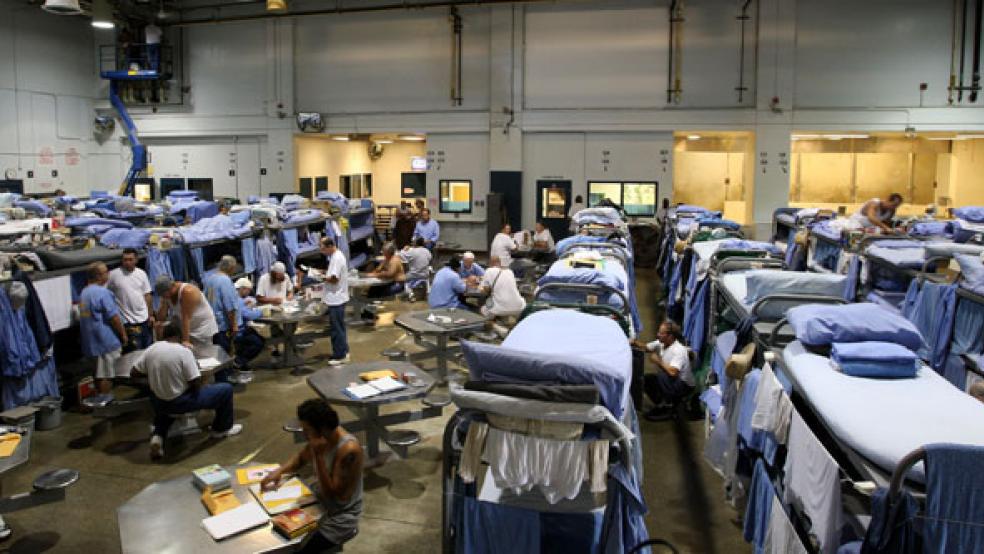For many years, states have been dealing with the skyrocketing medical costs of their inmates, especially as prison populations rose in the face of tough sentencing laws. But costs have peaked and begun to decline, due partly to innovations in managing prison medical care systems as well as greater reliance on federal Medicaid funds, according to a new study by the Pew Charitable Trusts and the MacArthur Foundation.
Between 2001 and 2008, prison health care spending rose dramatically as a percentage of overall spending and then peaked in 2009, at $8.2 billion – or roughly 20 percent of overall state prison expenditures for that year. The rising costs coincided with an historic surge in the number of people incarcerated in U.S. prisons as the government cracked down on drug addicts and dealers.
Related: Medicaid Expansion Cheaper Than Expected: CBO
The overall cost finally began to decline, as many states including California began to soften sentencing guidelines and to release or parole inmates to relieve overcrowding. Many state corrections officials also began tapping into the Medicaid program for low-income people to defray or cover inmate patients’ treatment costs.
States can be reimbursed by Medicaid to cover at least half of enrolled prisoners’ inpatient hospitalization costs, according to the study. They can save additional funds because Medicaid “typically pays the lowest provider rates of any payer in a state,” the report said.
What’s more, states that have agreed to expand Medicaid eligibility under the Affordable Care Act may actually achieve the biggest savings. Most prisoners, who are non-disabled adults without dependent children, will only become eligible for coverage of inpatient costs under this Medicaid expansion, according to the report – and will get a great deal. The federal government will initially reimburse the states 100 percent of the cost of covered services under this expansion.
Many corrections officials have also adopted cost-saving measures, including the use of electronic information and advanced telecommunications technologies to provide long-distance health care services to inmates in remote prisons. “This strategy can help improve prisoners’ access to primary care doctors and specialists while reducing transportation and guarding expenses,” the report said.
State officials have also contracted with outside organizations and businesses to provide health care services to inmates at lower costs.
Related: How the Mentally Ill Are Being Warehoused in Prisons
Nationwide, prison health care spending totaled $7.7 billion in fiscal 2011, down from the peak of $8.2 billion two years before. California accounted for most of this decline: It decreased its spending by $441 million between fiscal 2009 and 2011, according to the study.
“Health care and corrections have emerged as fiscal pressure points for states in recent years as rapid spending growth … has competed for scarce revenues,” the report noted. “As states work to manage prison health care expenditures, a downturn in spending was a positive development as long as it did not come at the expense of access to quality care.”
But the report cautions that states “continue to face challenges that threaten to drive costs back up,” chiefly the steady aging of the prison population that reflects the graying of the U.S. population. As the number of inmates who have grown old in prison dramatically increased, the cost of treating them has also risen.
Between 1999 and 2012, the number of state and federal prisoners who were 55 or older increased 204 percent – from 43,300 to 131,500.
Related: How Hepatitis C Could Wallop the U.S. in Next Decades
These older prisoner are prone to chronic physical and mental conditions, including hearing loss, diminished mobility, and dementia. It costs a lot more to treat older prisoners than younger prisoners: The National Institute of Corrections found that the annual cost of incarcerating prisoners age 55 and older with chronic or terminal illness is, on average, two to three times that of all other inmates.
For example, Vermont’s prison system, with its nearly 12 percent elderly inmates, reported average health spending per inmate at $11,015 between 2007 and 2011. Connecticut, with only 4 percent of its inmates at 55 or older, reported average health spending per inmate at $5,437 during that same period, according to the Pew-MacArthur study.
Some states have embraced medical or geriatric parole policies that would allow the release of older or terminally ill patients. But “states have released relatively few people” because of narrow eligibility critieria, according to the report. Many older and infirm prisoners, convicted of violent crimes or sentenced as habitual offenders, don’t qualify for parole.
“While spending began trending down from its peak in 2009, prison health care continues to pose a fiscal challenge for states,” said Maria Schiff, director of the State Health Care Spending Project, who oversaw the study.
Schiff says a variety of factors affect state-to-state spending comparisons, including the age and health status of prisoners, regional differences in the prices of health care services, and disparities in care quality and health outcomes.
“Because of these and the absence of measured outcomes, it is important to remember that higher spending is not necessarily an indication of waste, and lower spending not necessarily a sign of efficiency,” she said.
Top Reads from the Fiscal Times:


